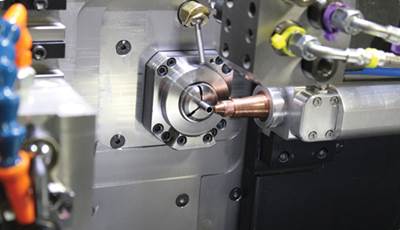The inherent flexibility of the Swiss-type machine tool configuration has been greatly enhanced with the application of CNC servomotor actuation in the place of mechanical cams. This trend continues with the development of CAD/CAM programming software that makes the transfer from design to tool path ever more efficient and user-friendly.
Shops of many stripes have seen these developments and jumped on the bandwagon to take advantage of the benefits they provide such as high production rates, close tolerance capability and the ability to produce complex geometries complete using single handling of the workpiece bar or blank. Historically, the Swiss-type machine has been primarily applied in “screw machine” shops. However, its increased capability, as well as application of CNC, have led to a branching out of this historically niched technology into other types of production environments.
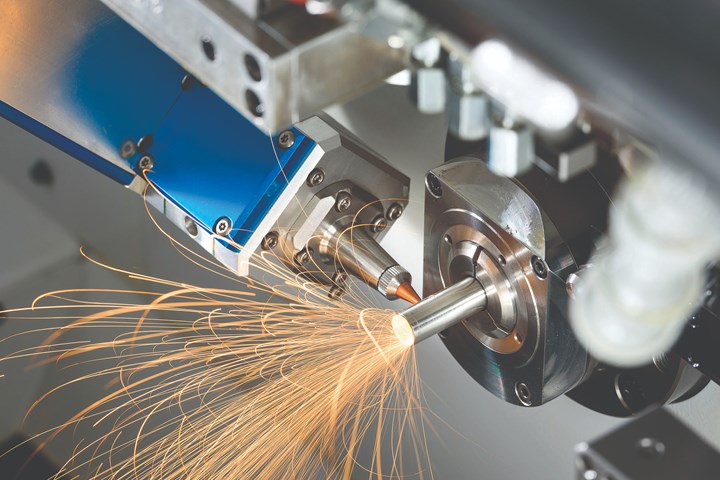
Using a laser cutting head on a Swiss-type machine enables Economy Spring to provide additional capabilities to its medical customers. Photo credits: Esprit CAM
The trend to non-traditional machining led us to visit Economy Spring & Stamping, a contract shop located in Southington, Connecticut. It was founded in the mid-1970s and today employs 190 people at its Connecticut location. The shop is one of 22 companies that comprise MW Industries based in Rosemont, Illinois, which collectively serves the spring, fastener, stamping and precision metal components industries.
In addition to its spring-making equipment, Economy Spring currently uses two 7-axis Swiss-type machines from Marubeni Citizen-Cincom. Each machine is equipped with a 400-W L2000 modular laser cutting system in which the laser cutting head resides in the machine’s cutting zone. Laser Swiss machining is a process departure that allows the company to perform operations that would require secondary or even tertiary production steps beyond its traditional niche.
Customer Driven
As the company name indicates, Economy Spring is a spring manufacturer. Springs, wire forms, and stampings of many sizes and shapes come off the shop floor’s banks of four-square machines and other wire processing technology. The two metalcutting Swiss machines look a little lonely in this sea of metal bending equipment, but they are serving a purpose as an investment in the company’s future.
The shop supplies the medical device industry with critical instruments that are manufactured using components that the company makes.
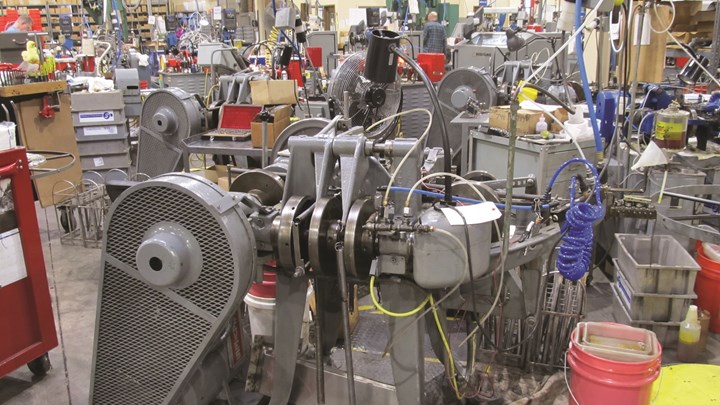
Economy Spring’s primary product has been manufacturing numerous types of springs, stampings and wire forms using four-square and other metal fabricating equipment.
Like many shops that serve the medical industry, the company is searching for ways to provide more processes and hence more products to the customer base that it serves. The pharmaceutical and medical device OEMs and contract manufacturers are looking to consolidate the number of suppliers with whom they interface.
“In one example,” says Tim Thompson, senior V.P. and general manager, “a major medical OEM is actively trying to move from 52,000 suppliers to a target of 10,000.” Shops such as Economy Spring want to be among those 10,000. To that end, the thinking behind the shop’s application of laser Swiss technology is to enable it to go after new work that is beyond its traditional niche.
Learning by Doing
The original impetus that led the company to look at laser cutting and eventually invest in the technology as applied on a Swiss machine came from one of its customers. According to Dan Bartlett, engineering manager, “We had a customer that wanted us to produce a 0.063-inch hole in a stainless steel tube used in surgery. We tried piercing it first using a secondary machine, but the results were not satisfactory.”
“We contracted with a nearby vendor that had a Citizen laser Swiss machine to see if they could do the job. They started making the part for us,” says Nick Coburn, project engineer. “We were trying to make these parts using conventional techniques, which weren’t working well for this application. After seeing the capabilities that our vendor was experiencing using a laser (in combination with Swiss cutting), it got the wheels turning for us to see what else that technology might bring to our shop.”
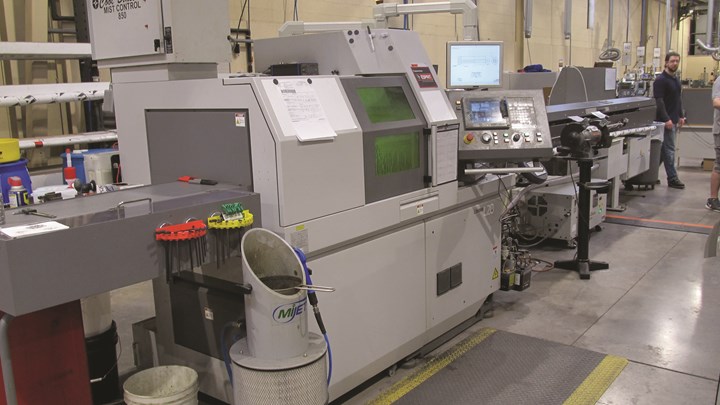
The shop’s first laser Swiss machine, a Citizen L220 Type 8, was installed in 2016. The development of laser cutting processes continues to open new avenues of business for the shop.
The shop bought its first Citizen machine in April 2016. It was equipped with a laser attachment, and the company began developing its in-house processes to make the job they had previously sent out.
However, the laser attachment opened opportunities for the company to make more parts, including a similar part using stainless steel tube stock that has an 0.020-inch OD and a 0.01-inch ID in which they are drilling a 0.007-inch hole. Understanding the benefits of the laser, the company ordered a second machine a year later.
The increased machining capability that the new machines bring to Economy Spring is freeing up designers of medical devices to design using specifications that weren’t possible before. “As the medical device community is learning that there are methods to produce fine holes as well as other types of cuts we are able to produce using the laser, they are seeking out companies with those capabilities,” Coburn says. “Their designers are advancing the capabilities of their instruments in step with our industry’s ability to manufacture the designs.”
Working With the Laser Swiss Machine
Dale Akerley, the department leader for Swiss applications, has a front-row seat for the company’s development of its processes involving the use of the machine-mounted laser.
“A benefit we see from the laser over conventional cutting tools,” he says, “is the laser cuts without wear. Conventional cutting tools wear over time and require compensation as they wear. Moreover, they exert cutting forces and often leave burrs on the workpiece. The laser does none of these things. With the correct gas, the HAZ (heat-affected zone) associated with laser cutting can be managed. Any dross left around the cutting area comes off in the cleaning process using an acid dip and ultrasonic parts cleaner.”
Production across the Citizen machines is set up like a job shop. They are not dedicated to a single job, rather the quick change-over of the laser makes small lot sizes practical.
In the shop, one of the Citizen machines is used for prototype and process development work. According to Coburn, “It can take as much as two years for a manufacturing process to become certified in the medical industry. In the meantime, those jobs that are already certified can be run in production on the second machine.” Production is generally in the 10,000 to 30,000 lot size range and made to existing orders.
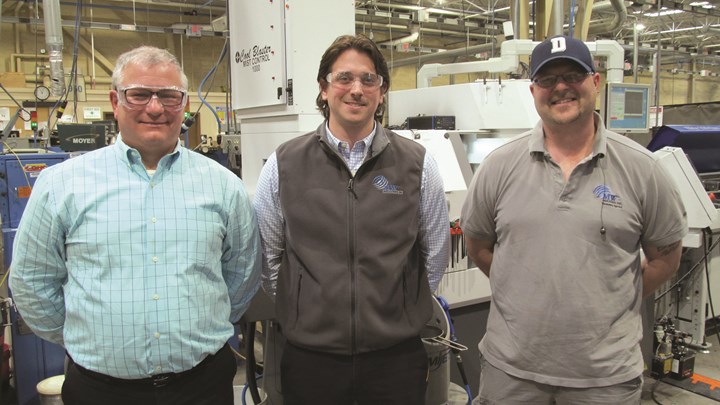
Economy Spring’s laser team, (left to right) Dan Barlett, Nick Coburn and Dan Akerley, is driving the development of the laser process technology on the shop floor.
The shop sees its laser cutting capability as a value-added service for its customers and rightly so. The company’s efforts at soliciting work for the machines focus on that capability in large part because the process is still relatively new to the industry. However, it is also working to integrate the metalcutting capability of the Swiss machine in concert with the laser.
Part Programming with CAM Software
The primary variables for part production on its Citizens include holding the part and ejecting the part. Beyond that, Economy Spring uses Esprit CAM software to program the machines. Toolpath generation is said to be relatively straightforward using the software’s inherent Swiss-type toolpath generation.
To make sure that the Swiss machining and laser cutting were compatible, Akerley, and other team members, attended a programming class in North Carolina to learn how to integrate the laser cutting operations into Esprit’s Swiss machining programming software to make the system seamless. This entailed taking the M and G codes for the laser, which were considered “add-ons” in the CNC and ensuring they were incorporated into the Esprit software. “It was a first for both parties,” he says.
Akerley began programming the tubes with Esprit by importing the SolidWorks CAD file that was provided by the customer. Importing the part geometry saves time and minimizes errors by ensuring that the program matches the customer’s original vision. The software then analyzes the imported geometry and automatically recognizes all the features.
Akerley then selected each feature of the part and chose a tool to machine those features on a graphical representation of the Swiss lathe. The knowledge base, included with the software, automatically generates typical machining parameters including cutting speed, feed rate, and depth of cut. Both the detailed features on the front end of the part and the holes were produced by the laser, which can produce virtually any geometric shape to an accuracy of 0.00001 inch.
To support his efforts, Esprit sent a technician to the shop who spent days working with Akerley to develop a postprocessor that automatically generates the instructions needed to set up the laser and perform the machining operations. With the post-processor in place, Economy Spring programmers treat the laser as if it were an ordinary cutting tool. The software then automatically generates the G-code instructions for the laser and metalcutting operations needed to produce the part.
What Can the Laser Do?
The initial application of the laser was to drill accurate, relatively small holes. Having mastered that, the company continued process development using the cutting ability of the laser to generate slots, spirals, helical shapes, widows and other complex shapes.
Cutting small holes accurately and without burrs is an example of an operation that the laser machine has enabled the shop to perform.
The basic laser is a fiber optic design and uses a 50-micron delivery fiber with kerf widths of 20 microns. Interpolating the main and secondary spindle’s C axes, and having the laser set at its correct focal length and depth of cut, opens up virtually any geometric shape for production.
The shop collaborates with its customers to develop the optimal use of the laser’s capabilities for the job that needs to be done. According to Coburn, “They will present us with a drawing that contains an idea, which represents what they want. We then provide them with other options that optimize the job in ways the customer may not have considered. It’s a two-way communication street.”
Citizen says its laser Swiss machine is able to cut and weld as well as laser-mark parts that are processed on its machines. Marubeni has laser welding available on the machine as well. It is probably only a matter of time before welding and marking become part of the company’s laser tool kit.
About the Lasers
The first machine that Economy Spring received was an L220 Type 8 with a 400W laser attachment. This Swiss machine model has eight axes of motion under CNC. Mounted on the tool slide, its laser is fed into the workpiece at a right angle in the cross-slide position. Type 8 can cut tube thicknesses of 0.0625 inch with a kerf width of 0.0015 inches.
For its second machine, and with some experience under the belt, the company opted for an L220 Type 12 machine (cable of 10 axes under CNC) with a more powerful laser attachment. Its laser can generate up to 3,000W of power and is qualified to cut 0.125-inch-thick tube stock and generates a 0.0035-inch kerf width. The second laser is mounted on the machine’s B axis for cuts that require angularity.
To survive in the cutting environment inside the machine tool, the laser head assembly is completely water-tight. In some applications, the use of high-pressure coolant is encouraged and is available as an option on the machine. This coolant can be directed into the workpiece and through the tubing from an automatic bar loader.
The Citizen laser attachments have available a fine X-Y beam alignment feature that uses an integrated camera to position the laser nozzle precisely at the start point of the cut. Both of the laser units used by the shop on its Marubeni Citizen machines are made by IPG Photonics, a U.S.-based manufacturer of fiber-optic lasers. The units are modular and can be installed in various new machine models as well as retrofitted on some existing machines.
Moving Ahead
All this may beg the questions: Is Economy Spring a technology pioneer? How risky is it for a metal bending shop to jump into seemingly advanced technology such as laser cutting on a Swiss-type machine tool?
The answers to these questions leads to another question: How risky is it not to get into this type of technology? With the backing of its parent company, Economy Spring is developing a skill set base that can offer process capabilities that are not commonly available and that show signs of being marketable. As the medical industry seeks to consolidate its supplier base, companies that can move ahead of the pack with new ways to perform operations and produce parts creatively and competitively stand a good chance of making the cut.
The team that the shop has assembled to develop its laser processing capability is enjoying the challenge of making this new technology work. For an engineer, it’s a green-field opportunity that doesn’t happen every day. As the laser development team says, “We have worlds to conquer.”
Economy Spring & Stamping | 800-225-6975 | mwlifesciences.com
Esprit CAM | 800-627-8479 | espritcam.com
Related Content
Precision Machining Technology Review October 2023
Production Machining’s October 2023 technology showcase includes some of the latest technology from Tungaloy-NTK America Inc., Renishaw, Walter USA, Seco Tools and Haimer USA.
Read MoreLone Shop Machinist Benefits From Five-Axis CAM Modules
This California shop owner applies five-axis strategies for more efficient milling of parts with challenging geometries, free-form surfaces and deep cavities.
Read MorePrecision Machining Technology Review: September 2024
Production Machining’s September 2024 technology showcase includes some of the latest technology from Expand Machinery, Paperless Parts, Monaghan Tooling Group, Walter USA and more.
Read MoreThe Control’s Role in Machining Complex Parts
This company that produces medical implants finds value in the CNC for its turn-mill equipment that helps speed setups and simplify programming when producing intricate parts complete.
Read MoreRead Next
Swiss-Type with Laser Cutting Capability
New capability for Swiss machines uses a laser.
Read MoreAdvances in Swiss-Type Technology
R&D efforts in recent years have led to higher efficiencies, increased agility and expanded capabilities for shops performing Swiss-type turning.
Read MoreSwiss Shop Chooses CAM Over Hand Programming
This shop’s manual (by hand) CNC programming was slowing it down until it discovered a CAM software for Swiss-type lathes.
Read More




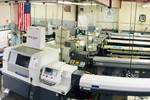




.jpg;maxWidth=300;quality=90)


.jpg;maxWidth=300;quality=90)







